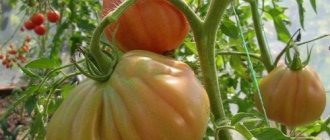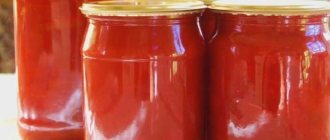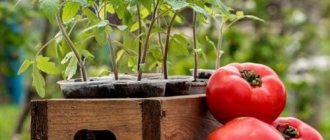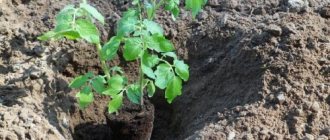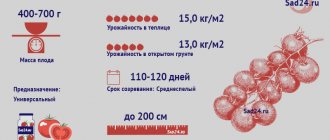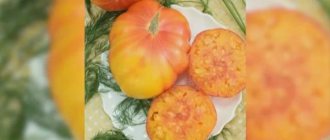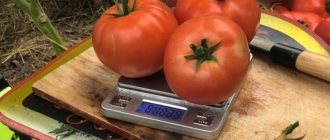An interesting and useful tomato, the Malachite Box attracts with its emerald-golden color and gigantic size. The taste is dominated by sweetish notes with sourness and a hint of honey. Cultivation does not cause any difficulties; the tomato bears fruit well throughout the country.
| Height | Landing location | Ripening time | Fruit color | Fruit size | Origin | Fruit shape |
| Tall | Greenhouse, Open ground | Mid-early | Bicolor | Large | Variety | Flat-round |
Description and characteristics of the variety
Tomato Malachite Box is an indeterminate tall variety. Bushes have the following features:
- stem height 1.5 m in open beds, 1.8 m in greenhouses;
- shoots are strong, strong;
- fruiting clusters 7-8;
- number of fruits 5-6.
The ripening period is mid-early - 98-105 days from germination. Tomatoes are harvested from summer through September. What are the properties of fruits:
- average weight 200-400 g;
- the largest specimens weigh 900 g from the lower branches;
- the color is bright - emerald stripes on a sunny yellow background;
- the pulp is fleshy, sugary;
- 4 seed chambers, few seeds;
- The skin is durable and resistant to cracking.
Fresh salads and slices are prepared from tomatoes and added to hot dishes. The juice and pastes are rich and aromatic.
Tomatoes Malachite box on video
If you grew Malachite Box tomatoes, please write how you liked them. What was the yield and taste of the fruit? Will you grow them again? How do you assess a variety's resistance to disease? If possible, attach to the comment a photo of the entire bush as a whole or individual fruits that you grew. Thank you!
Your additions to the description will help many gardeners evaluate this variety more objectively and decide whether it is worth planting or not.
This is a natural variety of tomato. Therefore, we recommend taking seeds from a ripe fruit and using them for planting in subsequent seasons.
Features of cultivation and storage
The seedlings are transplanted to a stationary place if the bushes have 6-7 true leaves. By this time, the plants reach the age of 50 days.
Place 3-4 bushes per 1 m2. The optimal distance between holes is 40-50 cm.
How to care for tomatoes:
- the bushes lead into 2 trunks, with this method the yield is maximum;
- water once every 4-5 days, the water norm is 7-8 liters per plant;
- fed with organic matter and complex fertilizers - “Agricol”, “Kemira-universal”;
- mulch with a layer of straw 8-10 cm.
Tomatoes are picked either at full ripeness or earlier for ripening. The fruits are stored for up to 3 weeks in dark, cool rooms.
Sowing dates and features of agricultural technology
You need to plant seeds for seedlings depending on your region of residence, but not earlier than the second ten days of March. Malachite Box seedlings tend to stretch.
Features of tomato cultivation:
- The bushes are spreading; 2 plants are planted per 1 sq.m.
- The seedlings are immediately tied to a support or trellis.
- The bush is formed into 1-2 stems.
- Carefully monitor the growth of stepchildren, remove them in a timely manner, preventing the shoots from becoming dense.
- The tomato is demanding on watering and fertilizing and does not tolerate drying out of the top layer of soil. Water the plant regularly, 1-2 times a week depending on the weather, abundantly.
- Mulching between rows facilitates weed control and serves as protection against fungal pathogens.
- The crop's brushes are fragile, with pronounced joints, and easily break under the weight of the fruit. Timely gartering of each hand helps to cope with the problem.
- In mid-August, the top growth point of the box is pinched. This technique allows the main crop to ripen.
- The plant, if agricultural practices are followed, bears fruit until late autumn and tolerates low night temperatures well.
It is better to pick tomatoes of this variety unripe than to allow them to become overripe. When harvesting is delayed, there is a significant loss of taste and presentation.
Description
Tomatoes of this variety are more of a late-ripening variety. But, it's very convenient. Since after the tomato season has passed, this species just begins to bear fruit. The bushes are quite tall, they can reach almost two meters. But, you need to remember that everything depends on the conditions under which tomatoes are grown.
An average of 5-7 fruits appear on one cluster. This variety can be grown both in a greenhouse and outdoors. This variability allows a person to start planting seedlings in advance, and without focusing on weather conditions. From the very beginning of growth, this variety requires staking and pinching.
In order for the yield to increase, it is necessary to form a plant with 2-3 stems. Many connoisseurs of “Siberian malachite” say that the bush looks elegant. Thanks to its aligned fruits.
Tomato “Malachite Box”: variety description, photo
Tomatoes are one of the most popular crops; many people love this red juicy fruit. However, tomatoes can surprise. Today we will get acquainted with a tomato of unusual color and taste - the “Malachite Box” variety.
Breeding history
The tomato variety “Malachite Box” was bred in Novosibirsk, its authors are V. N. Dederko and O. V. Postnikova. The variety was included in the State Register of Breeding Achievements of the Russian Federation in 2006, recommended for cultivation in open ground and under film cover.
Description of the bush
The height of the bush often exceeds one and a half meters. The plant is leafy and branched, the stems are thick, but easily break under the weight of the fruit.
The shoots, like those of other tomatoes, are covered with thick pile. The foliage is large, dark green. Simple inflorescences are tied on the lower racemes, forming large fruits.
Important! When growing, it is recommended to form a bush into two trunks, regularly removing side shoots. Crowding can attract insects and some diseases
Description of the fruit
The “Malachite Box” tomato is represented by round, slightly flattened fruits. They have a glossy thin skin that can be peeled off without much effort.
The color of tomatoes varies from green with yellow splashes to yellow with a bronze tint. The pulp of the fruit is dense, juicy, emerald in color, there are no more than four chambers with seeds, there are few seeds. We advise you to familiarize yourself with such varieties of tomatoes as “Chio-Chio-San”, “Slot f1”, “Niagara”, “Red Red”, “Cardinal”, “Sugar Bison”, “Red Guard”, “Collective Farm Harvest”, “ Labrador", "Caspar", "Gina".
Gourmets will appreciate the taste of tomato: fruity, with sweet notes and sourness, reminiscent of the taste of kiwi. It’s interesting that this miracle smells like melon.
Productivity
The “Malachite Box” variety pleases with its productivity: a tomato grown in open ground, from 1 sq. m allows you to harvest about 4 kg, as for growing in greenhouse conditions - the yield reaches 15 kg.
The fruits are large, weighing up to 400 g; with constant care and nutritional supplements, it was possible to grow tomatoes weighing 900 g.
Transportability
Due to the thin skin, the fruits do not tolerate transportation well, and for the same reason they are not stored for long. It is better to process them immediately or eat them.
Resistance to environmental conditions and diseases
Bred in Siberia, the variety tolerates cold and return frosts well, and also tolerates heat calmly.
Resistance to diseases is selective: Also in open ground conditions, the tomato is susceptible to attacks by pests.
Usage
The Malachite Box tomato variety is mostly used fresh, in salads, sauces, dressings, and ketchups. The juice is interesting in taste.
It is quite suitable for use in main courses: pizza, casseroles, vegetable and meat stews, etc. This variety is a godsend for allergy sufferers who cannot tolerate red fruits, berries and vegetables.
Advantages and disadvantages
The “Malachite Box” tomato generally has a positive characteristic; the description of the variety is more in favor of choosing this fruit. And the shortcomings are not so significant as to refuse it.
pros
- uniform ripening;
- high productivity;
- pleasant taste and appearance;
- high seed germination;
- there is no tendency for fruits to crack;
- weather resistance;
- resistance to fungal diseases;
- long fruiting period;
- quick adaptation after picking;
- large fruits.
Minuses
- susceptible to attacks by insects and some diseases in open ground;
- poor transport tolerance;
- low storage rate.
Was this article helpful?
Yes
No
Pest and disease control
To combat pests and diseases of tomatoes, the Malachite Box uses classic, effective means:
- Fungicides.
- Insecticides.
- Folk remedies: solution of baking soda, wood ash, liquid soap, ammonia, onion peel.
When growing a Malachite Box tomato in open ground, you should carefully inspect the bushes for the presence of Colorado potato beetles. If there is a heavy infestation this year, you can prepare potato traps: put chopped potatoes in jars and lure the pests.
Advice! If Malachite Box tomatoes are grown in open ground, it is best to spray fungicides or insecticides in the evening in calm weather.
Pros and cons of the variety
The advantages of the Siberian malachite variety include the following qualities:
- long fruiting;
- frost resistance;
- the ability to tolerate prolonged drought, overheating and dehydration with minimal loss of productivity;
- strong immunity;
- productivity;
- sweetish taste.
Among the disadvantages of the variety, one can highlight the need for shaping, tying and pinching the bush of the plant.
Siberian malachite tomatoes contain a large amount of carotene. The fruits do not cause skin allergies. As a result, tomatoes can be added to diet or baby food.
What people say
Many people will learn about “Siberian malachite”. It's like word of mouth. Since I planted one myself for testing, and, of course, he liked it, conversations begin about what a good variety it is.
No wonder. Reviews from gardeners who grow this variety are really only good. Since this representative is not whimsical, tasty and has a beautiful appearance. It is often called “striped” because of the stripes that differ from the main color of the fruit.
One of the main positive aspects of this variety is resistance to various diseases. It can grow under any conditions, but, of course, the better they are, the greater the harvest.
Another nuance, most people believe that the variety came from Siberia. This is not entirely true. Like any other vegetable, Siberian malachite does not tolerate extreme cold. That is why you should not exaggerate and invent things to yourself, this is just a name and nothing more.
You will not regret if you buy yourself such a copy. He has a lot of positive qualities, so there will be no problems with him. The main thing is that finding such a variety and planting it is as easy as shelling pears.
Specifics of cultivation
It is advisable to grow the Malachite Box variety in a greenhouse, since it is easier to care for tall bushes, and the yield is larger.
Preparing soil and containers
The Malachite Box tomato grows well in fertile, light soils. A simple solution for growing seedlings is to buy a nutrient mixture at a specialty store. You can prepare the soil yourself - mix equal parts of humus, peat and turf soil. There is no need to specially fertilize the soil, since the seeds do not particularly require fertilizing to germinate. It is better to fertilize the soil after germination.
The planting material is planted in a wide box, which is pre-disinfected (doused with boiling water or a solution of potassium permanganate). The strengthened seedlings are later planted in separate containers.
Seed preparation
Self-collected planting material is first sorted. For this, tomato grains are placed in a malachite box in a slightly salted solution. For sowing, grains that have settled to the bottom are collected.
See also Tomato Sunrise - description and characteristics of a hybrid of Dutch selection
Preparation for germination is carried out in several stages:
- to disinfect grains, place them in a pale solution of potassium permanganate for 20-30 minutes, then remove them and wash them under running water;
- to increase crop productivity, planting material is soaked in special preparations that stimulate growth: “Epin”, “Immunocytophyte”;
- The grains for germination are wrapped in wet gauze or cloth and placed in a warm place. It is necessary to constantly maintain the moisture of the fabric.
In order for the seedlings to better tolerate temperature changes, the sprouted seeds are hardened - placed in the refrigerator for 10-12 hours. Then leave it in a warm place for the same time and repeat the cycle 2-3 times.
Sowing seeds
Before sowing the seeds, prepare the soil: grooves 1.5-2 cm deep are made on the surface (rows alternate with a distance of 3-4 cm).
The sprouted grains are placed in grooves in increments of 2-2.5 cm and sprinkled with a little soil. The containers are covered with film or glass and placed in a warm place. When the first shoots appear, the boxes are opened and transferred to a well-lit place. Recommended air temperature is 15-17°C. In heat and light, seedlings can stretch, so it is important to ensure that the temperature does not rise.
In cloudy weather, the containers are additionally illuminated. Watering should not be done sparingly, as the seedlings will simply rot if they are over-watered.
Picking
The advantage of the Raspberry Box variety is that the seedlings tolerate transplantation well. As soon as 3-4 leaves appear on the sprouts, you can safely dive the plants into separate containers. The picking cannot be underestimated - the seedlings are placed in new fertile soil, and more space appears for growing the root system.
After picking, the tomato seedlings are fed. The best option is to use organic matter. The use of wood ash has several advantages - the natural remedy contains the necessary microelements and prevents the appearance of blackleg in seedlings.
Watering of picked seedlings should be moderate. Stagnation of moisture should not be allowed, but the formation of a dried crust on the soil is not welcome.
Transfer
Hardened seedlings are transplanted into a greenhouse or open beds in late May - early June. The site is prepared for the event 7-10 days earlier. The soil is dug up and loosened. To increase the temperature of the earth, you can cover the beds with polyethylene. For disinfection purposes, the wells are watered with a hot solution of potassium permanganate.
They make transfers on a cloudy day or set aside time in the evening. A distance of 40-45 cm is made between the holes. After transplanting, the seedlings are immediately tied to a support. If the seedlings are too elongated, they are placed in the hole at an angle and several of the lower leaves are torn off.
Diseases and pests
| Macrosporiasis The fungal disease is spread by wind and rain. Ways to fight:
| |
| Bacterial diseases The disease develops against the background of damage by pests or spores brought to the site. Ways to fight:
| |
| Viral diseases The virus is introduced through equipment, seedlings and seeds. Ways to fight:
|
Transplantation into soil
The most important condition for obtaining a good harvest is compliance with the recommended care. To transfer a plant, you must first select and prepare a place. You should not plant tomatoes in the place where they grew last season and the season before that, and you should also not plant them where nightshade crops were located before. The best predecessors for tomatoes are: carrots, zucchini or cabbage.
Siberian malachite is a heat-loving and light-loving plant; for it you need to choose a sunny place. Also, bushes are demanding on the composition of the soil; it must be loose, light and fertile. You should not fertilize tomatoes with fresh manure; this will not bring any benefit; instead of forming ovaries, the plant will begin to fatten and produce new shoots.
Some people believe that if you pick off the leaves, the harvest will be better, but this is a common misconception. After all, the leaves provide the ovaries with nutrients, so only yellowed or diseased foliage can be removed during the active period of fruit growth. Or wait for the moment when the tomatoes on the lower brush completely correspond to the desired size and then remove the leaves under the brush. But don’t get carried away; you can pick off no more than four leaves per week.
The bushes need to be tied up, because under the weight of the fruit they can break. Stepchildren should also be removed, otherwise the yield will decrease. If the weather is cloudy during flowering, the ovaries are poorly formed; in order to correct this, you can treat the plants with a solution of boric acid. It won’t be difficult to prepare, dilute 2 g of the substance in 10 liters of water, this amount will be enough for 100 square meters. If the weather still does not return to normal, the procedure can be repeated after 3 days.
Tomatoes love rare but abundant watering and loosened soil. Weeds need to be removed regularly as they appear. Temperatures in a greenhouse above 32 degrees are detrimental to plants, so it is necessary to constantly monitor it and provide timely ventilation. During the entire growing season, plants need to be fed at least 3 times, using complex mineral fertilizers or organic ones, for example, mullein solution or bird droppings.
Sowing work
This variety is sown 60-65 days before the expected date of planting in a permanent place. They buy land or make it themselves. Before planting, the seeds are disinfected in a special solution and then treated with a growth stimulator to reduce germination time.
The seeds are placed in pre-made grooves at a distance of about 2 centimeters from each other. The optimal temperature for seed germination is considered to be 24-26 degrees; after the sprouts appear on the surface of the earth, it can be reduced by several degrees. The appearance of one or two leaves signals that the seedlings are ready to be planted in separate containers; for this you can use cups, plastic containers or pots. Within 10 days, young seedlings begin to harden, this will help it gain strength and quickly adapt to a new place.
Plant care
When planting tomatoes in a permanent place, you need to make sure that the weather is warm, but not hot. It is better to do this in the evening. Seedlings are planted in holes: four plants per square meter for tall tomatoes and 6 for medium-sized tomatoes. You can add a handful of ash to each hole and pour warm water over it. The seedling is deepened, covered with soil and, if it is a tall species, tied to supports or trellises.
Further care of the plantings consists of:
- in weeding and loosening the soil;
- in timely watering;
- in stepsoning;
- in a garter;
- in pest control.
Weeding is needed to kill weeds so that the plants have enough fresh air and nutrients.
Watering should be done in the evening and only with warm water; the root system of seedlings suffers from cold water. To combat pests, you can use folk methods and remedies, or you can purchase chemicals and, following the instructions, treat the plantings.
When all the instructions are followed and the plants feel care and attention, they grow quickly, form flower clusters, set fruits and bring the desired harvest to their owners. After the first tomatoes ripen, they should be immediately harvested, processed, or eaten in fresh salads. Farms grow products for transportation and sale to the population
Farms grow products for transportation and sale to the population
It doesn’t matter so much whether you grew a crop or bought finished products, you need to start processing in order to diversify your homemade dishes in winter
When planning to plant your favorite variety, you first need to find out what its characteristics are, find a description of the species, and look at the photo. The yield of bushes will depend on compliance with the rules of care, on timely measures to protect plants from weeds and pests. When the vegetable grower adheres to the recommendations, then the pets will thank him with an abundance of tasty and colorful fruits. Grow tomatoes of apple varieties, admire them, eat them for your health and share the sweet and tasty sunshine of summer with your friends.
Characteristics
Gardeners and farmers value this variety of tomato for its exotic taste: sweetish, with a melon flavor and the sourness of kiwi. It does not at all resemble the traditional taste of a tomato. It is noted that the berry contains a moderate amount of pulp and liquid, acid and sugar.
The skin of tomatoes is very thin and can be easily peeled off when cooking. But for the same reason, tomatoes are poorly transported and stored. “Malachite Box” is a salad tomato variety that is not suitable for preservation in its entirety. Also used for making juice and sauces. This variety will be appreciated by tomato lovers who suffer from allergic reactions to red foods.
The undoubted advantages include:
- unique color and unusual taste;
- possibility of growing in open ground and under film covers;
- the fruits do not crack;
- bear fruit until late autumn.
According to experienced gardeners, the disadvantages of the variety are:
- difficulties during transportation;
- when overripe, the fruits become too watery;
- Because of the green color, it is difficult to determine the degree of ripeness of the fruit.
Advantages and disadvantages of the variety
The variety produces large, very tasty tomatoes that appear throughout July and August, often until September. Summer residents especially value them not only for their aesthetic appeal, but also for their very unusual taste.
Tomatoes usually ripen at the same time, fruiting continues until early autumn
pros
- high productivity;
- unexpected fruity taste;
- good seed germination;
- high resistance to diseases;
- the fruits on the bushes do not crack.
Minuses
- Fruits cannot be stored for a long time;
- they are not suitable for pickling and pickling;
- The skin is thin, so it may not withstand long transportation.
